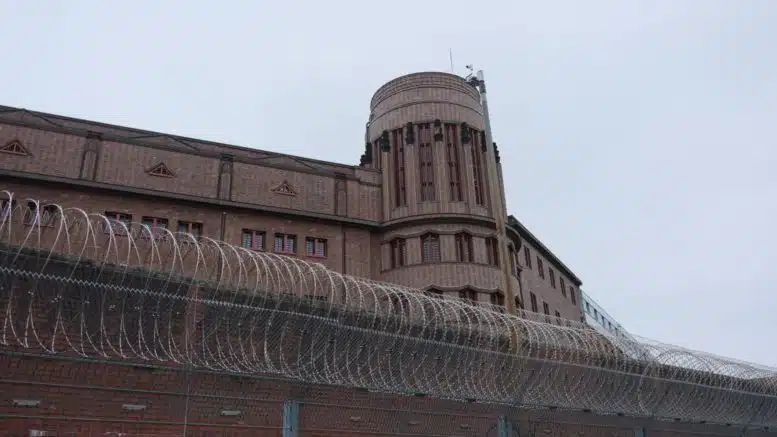By Rachel Crumpler
In May, Craig Waleed went to Europe for 10 days. He wasn’t visiting tourist sites or checking out the beaches on a late spring holiday. Instead, he used his time abroad to step inside five prisons located in Germany and Norway.
The trip, organized by the ARrow Center for Justice, brought together 15 people engaged in work related to the criminal justice system — from correctional wardens to lawyers to advocates — eager to see what insights they could glean from visits to prisons in two European countries known for having prison systems vastly different from that in the United States.
Waleed, who spent nine years incarcerated in New York, said he saw many things that differed starkly from the U.S. prison system.
NC Health News reporter Rachel Crumpler spoke with Waleed about his takeaways from the trip and how it will inform his work as project manager for Unlock the Box, a campaign against solitary confinement, at Disability Rights NC. The conversation has been edited for length and continuity.
NC Health News: What interested you about participating in this trip?
Craig Waleed: My life’s work has been around carceral matters — liberation, freedom, justice and equality. So this was right up my alley. Whenever we go outside of our comfort zone, or what is familiar to us, there’s the potential to learn because we get an opportunity to see something that we know, done in a different manner.
I’m really concerned about the outcomes of people when they’re leaving prison — the health outcomes, the social outcomes, the psychological outcomes. This was an opportunity to perhaps learn how to do incarceration differently over here.

NCHN: What did you do on your visits?
Waleed: We engaged with correctional officers. We engaged with incarcerated people. We had dialogue. We walked through the entire prisons, saw the solitary units, saw the living units. The prisons and their security seemed so different from the United States.
Though the exterior of all of the places were surrounded by a tall barbed wire fence, there were no gun towers. Inside the cells looked more like dorm rooms. A lot of the units had kitchens in them. It looked and felt different. It didn’t seem like a place where someone had to worry about getting punished again, you know, being put in prison is the punishment.

Here, you get put in prison, then you get punished even more by the environment, by the correctional officers, by all restrictions.

NCHN: Why go see the Germany and Norway prison systems?
Waleed: I think these particular systems are serving as role models for prisons or correctional systems around the world. One of the things that they’re really focusing on is transformative power. They’re focusing on restoration. They’re focusing on human dignity.
This principle of normality is also practiced over there. They realize most people are getting out in a short time because they have short sentences on average, so they’re trying to help people mimic regular, everyday life instead of institutional life.
NCHN: What about your trip or conversations with folks stood out most?
Waleed: My focus is really on solitary confinement. Everywhere I went, I asked specifically about how solitary is conducted in the prisons. Solitary confinement is a cuss word. I would say it’s almost the equivalent in those prisons as to what the N word is in our society — you just don’t say it. So every time I asked about solitary confinement, you could see people’s faces — the correctional officers, the staff — becoming a little contorted. They all answered that they use isolation as little as possible.
One time when I asked about solitary, they said, “We’ll try to take you over there.” A short time later, they said, “Someone’s in solitary right now. Maybe they’ll be out by the time we get to that side of the prison.” They were out when we got over there. That shocked me.

They keep them in for a shorter period of time. Prison staff said someone might go in for 45 minutes or an hour a day and during that time there’s someone, they say, that’s constantly checking on the person. That just made it seem a bit more humane and stood out to me.
Here in the United States, people are inside solitary for weeks, months and even years. A large percentage of people are there for low-level, nonviolent offenses.
NCHN: Did the prison officials share how they are able to limit their use of solitary confinement? What alternatives are used?
Waleed: One of their alternatives is to talk. They train their correctional officers almost to be like case workers or counselors. In Norway, correctional officers are given a caseload. They have X amount of incarcerated people that they’re responsible for working with, not just watching over them and making sure they don’t jump the fence or take too much bread from the commissary. It’s really about talking through problems, helping them with plans when they get out.
One of the things a correctional officer said to me is that, “By putting them in the box, we’re not working on any issue. We’re just covering it up. When they get out of the box, it’s going to be the same issue but worse.”
The correctional officers have been trained on how to build relationships with the folks who are incarcerated. Relationships to the point where correctional officers share meals with incarcerated people, like, sit down in the cafeteria with them, play with them on the soccer pitch, walk the yard with them and talk with them. There’s this balance between caregiver and security.

NCHN: In addition to less reliance on solitary confinement, was there anything else you observed from these prison systems that particularly contrasted with how the U.S. prison system operates?
Waleed: What we learned over there is that the primary goal of incarceration is restoration of the individual and the community. They have more smaller prisons that are closer to where people have been arrested, closer to where people’s families are. There’s this communal attitude in Germany and Norway — at least where we visited — where incarceration alone is the punishment. They still want to help people stay connected to their families and their communities and resources. American prisons are much more punitive and retributive.
NCHN: You spent several years incarcerated in a New York prison. Did you have any reflections on how your own experience could have been different if you had been incarcerated in one of these European prison systems?
Waleed: I didn’t spend a whole lot of time on it because I’ve been out for over 25 years. A lot of my thinking is forward at this point. But I do remember thinking, “Wow, if I had to go to prison and it was in a place like this, some of my post-incarceration struggles probably would not have existed, such as facing and dealing with the stigma from the community and also dealing with the post-traumatic stress of being incarcerated.”

I still have nightmares to this day. I take a sleeping aid to just keep me sleeping heavy. Because without it, these dreams come and I wake up in sweats, breathing hard. It’s from the trauma of living in prison. A more humane environment that’s less traumatic — that would have helped.
NCHN: Do you think the U.S. prison system can make changes to be more like the European prison systems you saw?
Waleed: Our prison system is steeped in its own culture. That culture is hard to change.
My hope is to see some incremental changes beginning to happen, which are happening here in the United States in various pockets in different corrections systems, but to see the entire nation change would be the equivalent to maybe turning a bus around in an alley. It could happen but the bus is going to be very banged up.
Sign up for our Newsletter
“*” indicates required fields
But because I see it happening abroad, I know that it’s possible.
NCHN: Any ideas for how progress can be achieved?
Waleed: I think it’s important for officials to go on these trips, read the research, maybe experience solitary confinement for themselves. Sometimes when we experience stuff, that’s the only way that we can really understand it. I think raising public awareness is also important because public funds — our tax dollars — fund prisons. Having more instances where incarcerated people or formerly incarcerated people and their family members can speak about how prison impacted them is also critical.









